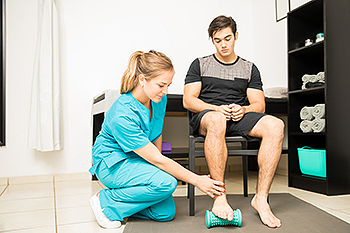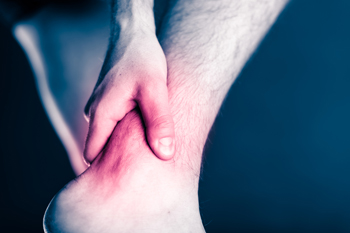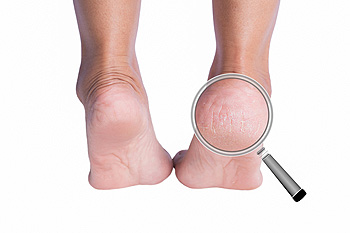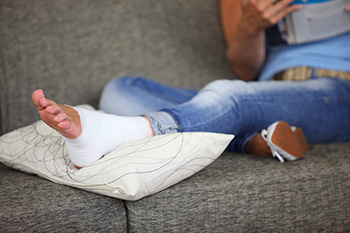Items filtered by date: November 2022
What Is Plantar Fasciitis?

Research shows that millions of people suffer from heel pain each year. Heel pain is usually felt on the underside of the heel, and less often behind it. While heel pain is not generally a symptom of a serious health problem, the pain can greatly interfere with exercise and normal functioning. Also, persistent heel pain can become chronic if left untreated. Often, heel pain results from plantar fasciitis, an inflammation of the plantar fascia, the band of connective tissue running from the heel to the toes on the underside of the foot. This condition can occur from overuse, repetitive exertion, and non-supportive shoes. Intense pain is felt in the heel and sometimes in the arch area of the foot and is particularly bad when resuming activity after a period of rest. Insoles and stretching can help alleviate this type of heel pain. If your heel pain does not go away in a reasonable amount of time, set up an appointment with a chiropodist who can make an accurate diagnosis and provide treatment options.
Plantar fasciitis can be painful and interfere with your daily activities. If you are experiencing foot or heel pain and believe you may be afflicted with plantar fasciitis, please consult with Chiropodist Stephanie Poupore from North Bay Foot & Ankle. Our clinician will assess your condition and provide you with quality foot and ankle treatment.
What Is Plantar Fasciitis?
Plantar fasciitis refers to the inflammation of the plantar fascia, a ligament that runs along the bottom of the foot and connects the heel bone to the toes. Repetitive activities, such as running or jumping, can injure the plantar fascia over time. Plantar fasciitis can also be caused by flat feet, high arches, pregnancy, and activities that put excessive pressure on your feet, like standing all day for work. When the plantar fascia becomes inflamed, it causes pain and discomfort.
Symptoms
Typical symptoms of plantar fasciitis include:
-
Stabbing pain near the heel
-
Pain that is worst in the morning or after a period of rest
-
Pain that increases after exercising
-
Swelling
-
Tightness in the Achilles tendon
Diagnosis
Plantar fasciitis is typically diagnosed via medical history and physical examination.
Treatment
Treatments for plantar fasciitis include resting and icing the affected foot, stretching the foot, taking medications to reduce inflammation, and wearing orthotics. In severe cases where pain does not improve with conservative treatments, injections or surgery may be recommended.
If you have any questions, please feel free to contact our office located in . We offer the newest diagnostic and treatment technologies for all your foot care needs.
Facts About Achilles Tendonitis

Achilles tendonitis is an injury of the long tendon at the back of the heel. It is usually the result of overuse, but there are many other causes, including overpronation, incorrect footwear, and wearing high heels. Symptoms of acute Achilles tendonitis include pain and stiffness in the area of the Achilles tendon. Pain is normally felt when first waking up, but is likely to diminish as the tendon warms up. Pressing in or squeezing from the sides evokes tenderness, and a nodule or lump may be felt in the tendon. Many of these symptoms also appear in chronic tendonitis, but they can become worse during exercise. Further, walking uphill or up stairs may cause pain. These are warning signals that Achilles tendonitis may be more serious, and if ignored the Achilles tendon could rupture. A chiropodist can determine the severity of Achilles tendonitis through an MRI or ultrasound scan. There are a number of ways to treat Achilles tendonitis, but getting treatment quickly is extremely important. Please see a chiropodist for further information about treatment options.
Achilles tendonitis is a common injury of the Achilles tendon, a band of fibrous tissue that runs along the back of the lower leg. The Achilles tendon can also rupture, making it impossible to lift the foot. If you are suffering from heel or calf pain, please consult with Chiropodist Stephanie Poupore from North Bay Foot & Ankle. Our clinician can help you maintain the health of your lower limbs and your mobility.
Causes of Achilles tendon injuries include:
-
Repetitive stress or overuse
-
Sudden increase in activity levels
-
High impact injury
-
Calf muscle tightness or weakness
-
Altered foot biomechanics
-
Heel bone spurs
-
Underlying medical conditions that weaken the tendon
Symptoms of an Achilles tendon injury include:
-
Heel and calf pain that worsens following exercise
-
Chronic heel and calf pain
-
Sudden pain in the back of the ankle or calf
-
A popping or snapping sensation
-
Thickened lump in the Achilles tendon
-
Ankle and calf stiffness
-
Decreased range of motion in the affected foot
-
Swelling
-
Difficulty walking
Treatment
-
Resting the affected leg
-
Applying ice
-
Compressing the foot and ankle
-
Elevating the injured leg
-
Wearing orthotics
-
Low impact exercises
-
Stretches
-
Strengthening exercises
-
Non-steroidal anti-inflammatory medications
-
Cortisone injections
-
Surgery, if the tendon is ruptured
Achilles tendon injuries can be very painful and lead to reduced mobility if left untreated. If you have any questions, please feel free to contact our office located in . We offer the newest diagnostic and treatment technologies for all your foot care needs.
Reminder: When Was the Last Time...?
Reasons People Can Get Cracked Heels

Cracked heels can simply be due to dry skin. However, walking barefoot, callus buildup, wearing shoes that do not have sufficient heel support, and aging can also lead to cracked heels. More seriously, cracked heels can occur from other medical conditions including diabetes, fungal infections, or deficiencies in vitamins C, B3, or E. This condition can be painful and even start to bleed. In addition to wearing supportive footwear and moisturizing the feet, tending to a diet that provides sufficient nutrients and vitamins is recommended to prevent this affliction. If you have cracked heels and they are worsening, bleeding, or appear infected, contact a chiropodist as soon as you can.
Dry, cracked heels are more than a cosmetic inconvenience. For many people, they are uncomfortable, deep, painful, and may even bleed. If you suffer from cracked heels, please consult with Chiropodist Stephanie Poupore from North Bay Foot & Ankle. Our clinician can help you maintain the health of your lower limbs and your mobility.
Causes
-
Prolonged standing
-
Wearing open-back shoes
-
Wearing shoes that don’t cushion the heels
-
Living in a cold or dry climate
-
Taking long, hot showers
-
Not moisturizing the heels
-
Eczema
-
Psoriasis
-
Palmoplantar keratoderma
-
Juvenile plantar dermatosis
Treatments
-
Soaking the feet
-
Exfoliating with a pumice stone
-
Moisturizing the heels
-
Wearing closed-back shoes that cushion heels
-
Avoiding prolonged standing
-
Taking warm, rather than hot, showers
-
Treating underlying skin conditions
While milder cases of cracked heels can be treated at home, some patients present with deep, painful, bleeding heel fissures that are at risk of becoming infected and may require medical care. Additionally, patients with diabetes or any other conditions that affect the immune system should be monitored by a chiropodist.
If you have any questions, please feel free to contact our office located in . We offer the newest diagnostic and treatment technologies for all your foot care needs.
What You Need to Know About Athlete’s Foot

Athlete’s foot or tinea pedi is a fungal infection that affects the upper layer of skin on the foot, especially when it is warm, moist, or irritated. The fungus causing this infection is called Trichophyton, and it’s usually found on floors and in clothing. Athlete’s foot typically occurs between the toes or on the soles of the feet. It can cause burning, stinging, redness, cracking, and itching. Some people also find that their skin flakes. If open sores develop, this may cause a bacterial infection. Athlete’s foot is highly contagious, so it is important not to share shoes, socks, or any items that touch the affected area with others. Do not walk barefoot while being in locker room areas, near pools, or communal shower areas. Make sure the feet have enough room to breathe in shoes made of leather or canvas. This may help to avoid ideal conditions for the fungus to thrive when the toes are squeezed together. Athlete’s foot can be treated and it is suggested to see a chiropodist for treatment options.
Athlete’s foot can be uncomfortable and unsightly. To learn more about preventing and treating this condition, please consult with Chiropodist Stephanie Poupore from North Bay Foot & Ankle. Our clinician will assess your condition and provide you with quality foot and ankle treatment.
What Is Athlete’s Foot?
Athlete’s foot refers to an infection of the skin on the feet that is caused by a fungus. This fungus is contagious and thrives in warm and moist environments. It is often spread in common areas such as public pools, locker rooms, and showers. It can also spread when sharing personal items, like shoes or towels, with an infected person.
Symptoms
The symptoms of athlete’s foot may include:
-
Itching, stinging, or burning of the skin on the feet
-
Cracking or peeling skin, especially between the toes and on the soles of the feet
-
Scaly, red rash on the foot
-
Blisters
-
Foul odor
Treatment
Treatment for athlete’s foot typically involves using over-the-counter topical antifungal medications on the feet. When over-the-counter options are ineffective, you may need to take prescription oral medications or topical antifungal drugs, or a combination of both.
Prevention
Preventing athlete’s foot places an emphasis on good foot hygiene practices.
You can prevent athlete’s foot by:
-
Washing and drying your feet thoroughly every day
-
Wearing shoes when walking in public areas
-
Not sharing personal items, like shoes or socks, with others
-
Wearing shoes and socks made out of breathable materials
If you have any questions, please feel free to contact our office located in . We offer the newest diagnostic and treatment technologies for all your foot care needs.
Preventing Re-Injury to a Sprained Ankle

One of the easiest ways to re-sprain an ankle is to go back to your sport or activity before the ankle has had ample time to heal. This course of events frequently develops into ankle instability that can become chronic. But there are ways to prevent repetitive ankle sprains from happening. It is believed that some movement of the ankle aids the healing process, but that too much movement makes it worse. Wearing an ankle brace may be the perfect solution. Some experts suggest that using a brace for four to six weeks while recovering from an ankle sprain can significantly reduce healing time. An ankle brace can support the joint through compression while restricting the range of motion. For instance, it allows the ankle to move up and down, but stops it from turning inward or outward, thus protecting the ligaments from further damage. There are many types of ankle braces available, but none is perfect for every condition. For further guidance on which ankle brace may be best for you, please consult a chiropodist.
When one or more ligaments in the ankle overstretch or tear due to injury, an ankle sprain occurs. If you would like to learn more about ankle sprains, please consult with Chiropodist Stephanie Poupore from North Bay Foot & Ankle. Our clinician can help you maintain the health of your lower limbs and your mobility.
Symptoms of an ankle sprain vary depending on the severity of the injury, but may include:
-
Pain
-
Swelling
-
Bruising
-
Tenderness
-
Difficulty walking
-
Ankle instability
-
A reduced range of motion in the ankle
Treatments for an ankle sprain may consist of:
-
Resting the injured ankle
-
Applying ice
-
Elevating the ankle
-
Compressing the ankle
-
Over-the-counter pain medications
-
Ankle braces or other devices to take weight off of the ankle
-
Ankle exercises
-
Surgery (in rare cases)
It’s important for the sprained ankle to heal correctly and fully in order to avoid repeated injury. If you have any questions, please feel free to contact our office located in . We offer the newest diagnostic and treatment technologies for all your foot care needs.

